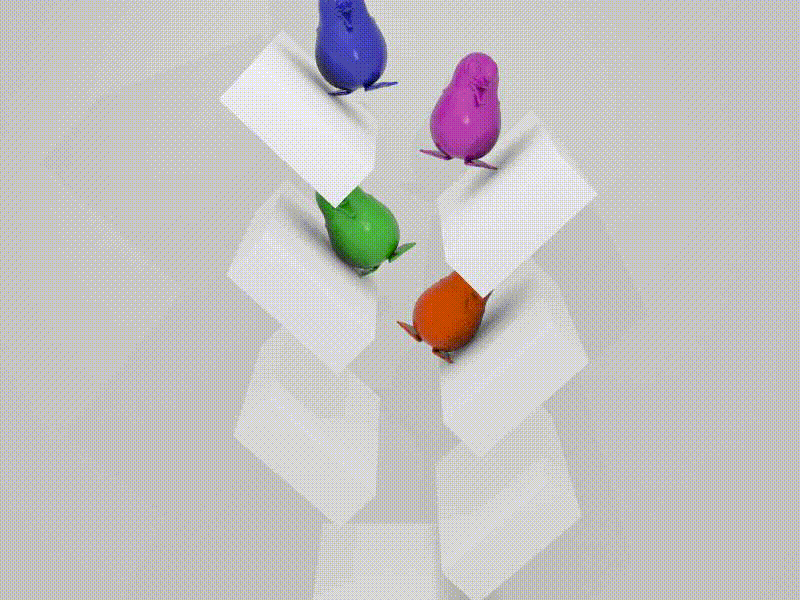Prof. David I.W. Levin
Email: diwlevin@cs.toronto.edu
Webpage
Office Hours: Thursdays 17:00-18:00 first two weeks on Zoom Zoom link will be sent to registered students
Yixin Chen
Haoda Li
Jonathan Panuelos
Email Instructor and TAs: csc417tas@cs.toronto.edu
Thursday 15:00-17:00 first two weeks on Zoom
Tuesday 10:00-11:00 first two weeks on Zoom
Zoom links will be emailed to registered students
Discussion board using Piazza
Hand in assignments using MarkUs.
This course is designed to introduce students to the field of physics-based animation by exposing them to the underlying mathematical and algorithmic techniques required to understand and develop efficient numerical simulations of physical phenomena such as rigid bodies, deformable bodies and fluids. In Physics-Based Animation we will learn how to develop algorithms that produce visually compelling representations of physical systems. We will learn the underlying continuous mathematics describing the motion of physical objects, explore how to discretize them and how to solve the resulting discrete equations quickly and robustly.
Prerequisites: C/C++ Programming, Linear Algebra, Calculus, Numerical Methods
The student is expected to read background material as necessary and should be comfortable with elementary linear algebra, geometry, and vector calculus. It is also assumed that the student is comfortable programming in basic C++.
(Strongly) Recommended preparation: Multivariable Calculus
The Variational Principles of Mechanics (Book)
Numerical Methods for Evolutionary Differential Equations (Book)
Fluid Simulation for Graphics (Book)
Fluid Simulation for Graphics (Notes)
Real-time Collision Detection (Book)
FEM Simulation of 3D Deformable Solids (Website)
Matrix and Linear Algebra Identities (PDF)
Material Point Method SIGGRAPH Course (PDF)
Two-Minute Papers (YouTube not strictly physics, but cool)
Prof. Shinjiro Sueda's Rigid Body Mechanics Notes for Joints
Great Book on Geometric Time Integration by Hairer
libigl for geometry processing
NOTE: Video and Assignment content maybe updated as the course progresses
Academic Honesty (required reading)
The final project should involve implementing one physics-simulation algorithm from a number of choices provided by the professor (coming soon). The projects will be taken from popular research papers. While the course will cover all the mathematical an technical concepts required to complete the projects, it will not cover the algorithms in detail. Projects can be done in up to groups of two (2) with no exceptions.
UPDATE: Implement an algorithm from one of these papers, more complete implementations are expected from lower degree of difficulty submissions
Deliverable: The code for your algorithm (in Python, C++ or MATLAB) along with instructions to compile and run the implementation. A two (2) page writeup of the algorithm in the style of a short SIGGRAPH paper. A 5-minute SIGGRAPH style video showing the results of your method.
Due Date: December 21st at 11:59pm.
Suggested Structure
Treat your video like a 5-minute presentation of your work (in lieu of a final presentation). You don't have to show yourself in the video, but a good suggested organization is (1) Introduce the problem (2) Mention the important resources you used (3) Outline the algorithm (4) show some results.
Document Templates (use Technical Brief)
| % | Item |
|---|---|
| 60% | Assignments (top 5 of 6) |
| 40% | Final Project |
Please read, this course has an involved late policy aimed at giving you maximum flexibility in scheduling your semester
Assignments are due by 11:59pm on the three due dates below.
0.007% off for every minute late.
Assignments 1,2,3,4 must be handed in by November 19th at 11:59 pm.
Assignments 5 and 6 must be handed in by December 17th at 11:59 pm.
The final project must be handed in by December 21st at 11:59 pm.
Extensions to the dates above can only be issued by the instructor.
THERE ARE NO LATE PENALTIES APPLIED TO ANY OTHER DEADLINES ASIDE FROM THE THREE (3) DEADLINES DIRECTLY ABOVE THIS TEXT.
**IMPORTANT: ** Students who hand in their assignments on the due dates in the schedule above will be awarded a five (5) percent bonus on the assignment grade up to a maximum score of one-hundred (100) percent.
Academic honesty is a very serious matter and can result in very serious consequences. Note that academic offences may be discovered and handled retroactively, even after the semester in which the course was taken for credit. This is a challenging class aimed at teaching you the fundamentals of computer graphics. You wont learn much if you cheat but you might get a good grade if you get away with it. If all you want is a good grade take an easier class where you wont have to cheat!
For purposes of this class, academic dishonesty is defined as:
- Any attempt to pass off work on an assignment that didn't come straight out of your own head.
- Any collaboration on written or programming assignments (its ok to share ideas on programming assignments but the code MUST be your own) in which the collaborating parties don't clearly and prominently explain exactly who did what, at turn-in time.
- Any activity that has the effect of significantly impairing the ability of another student to learn. Examples here might include destroying the work of others, interfering with their access to resources (e.g., digital cameras), or deliberately providing them with misleading information.
- Use GitHub issues for answering questions about class subject matter or about the assignments. The TAs and the instructor will monitor the issues pages. Email sent to the instructor or TAs regarding these matters will be ignored.
- Remark requests will be handled through MarkUs.
- Appropriate use of issues page: clarifications on assignment, on lecture material, general concerns about the course, or other remarks that are appropriate for all students to see/participate in.
- Do NOT broadcast pieces of your code or answers to written assignments to the issues page. Specific or general implementation questions whose answer would benefit all students in the class are appropriate.
- Questions of the form "I cannot find the problem with my code; here it is, can you help me" are unlikely to be replied, so don't count on it.
